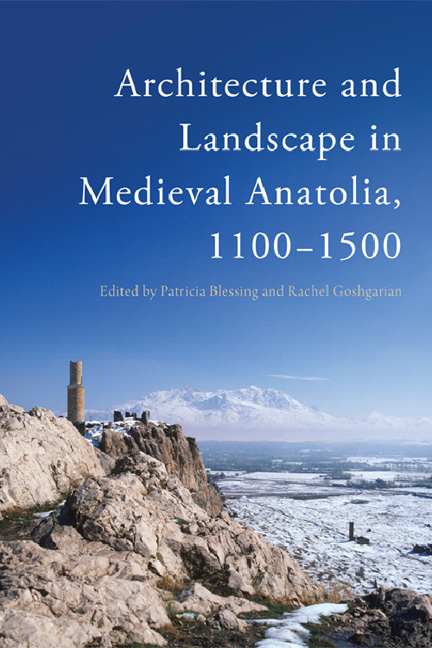Book contents
- Frontmatter
- Contents
- List of Illustrations and Tables
- Acknowledgements
- Foreword
- Map
- 1 Introduction – Space and Place: Applications to Medieval Anatolia
- Part I Building: Masons and Infrastructure
- Part II Social Groups: Akhis and Futuwwa
- Part III Exchange: Islamic and Christian Architecture
- Part IV Frameworks: Language, Geography and Identity
- 8 Harvesting Garden Semantics in Late Medieval Anatolia
- 9 All Quiet on the Eastern Frontier? The Contemporaries of Early Ottoman Architecture in Eastern Anatolia
- 10 The ‘Dual Identity’ of Mahperi Khatun: Piety, Patronage and Marriage across Frontiers in Seljuk Anatolia
- Notes on Contributors
- Bibliography
- Index
10 - The ‘Dual Identity’ of Mahperi Khatun: Piety, Patronage and Marriage across Frontiers in Seljuk Anatolia
from Part IV - Frameworks: Language, Geography and Identity
Published online by Cambridge University Press: 03 January 2018
- Frontmatter
- Contents
- List of Illustrations and Tables
- Acknowledgements
- Foreword
- Map
- 1 Introduction – Space and Place: Applications to Medieval Anatolia
- Part I Building: Masons and Infrastructure
- Part II Social Groups: Akhis and Futuwwa
- Part III Exchange: Islamic and Christian Architecture
- Part IV Frameworks: Language, Geography and Identity
- 8 Harvesting Garden Semantics in Late Medieval Anatolia
- 9 All Quiet on the Eastern Frontier? The Contemporaries of Early Ottoman Architecture in Eastern Anatolia
- 10 The ‘Dual Identity’ of Mahperi Khatun: Piety, Patronage and Marriage across Frontiers in Seljuk Anatolia
- Notes on Contributors
- Bibliography
- Index
Summary
In surveys of Islamic art, Turkic dynasties are often credited for the prominent role women enjoyed as patrons of architecture. This appears to be true for Seljuk Anatolia: the mothers, daughters and wives of the Seljuk sultans studded the urban and rural landscape with an array of buildings, leaving their names and legacies for posterity. Even though the Seljuks are known for their patrilineal genealogy that traces them back to Central Asia and Iran, their matrilineal genealogy – often characterised by local political alliances in the form of marriages – rooted the dynasty in Anatolia. Marriage alliances played key roles in establishing and cementing partnerships. Given the Anatolian realpolitik at the time, these could be with other Muslim polities as well as with Christian courts. While written sources circumscribe the narrative to men, this is in sharp contrast to the visible presence of women across Anatolia brought to life by their architectural patronage.
The knots tied across frontiers have lead scholars to question Seljuk ethnic, linguistic and religious affiliations through the lens of ‘identity’. This term itself is one laden with its own body of literature that is beyond the scope of the present chapter. In order to narrow down the focus, this chapter argues that the pattern of ‘dual identity’, as articulated by Rustam Shukurov, can be extended to include women of the dynasty as well. Perhaps the most prominent case is that of Mahperi Khatun, reported to be of Greek or Armenian origin, who was the first wife of Sultan Ala al-Din Kayqubad (r. 1220–37) and the daughter of the ruler of Kalonoros (today's Alanya) from whom the sultan had taken the city in 1221. The best-known examples of female patronage from the first half of the thirteenth century belong to this woman, who became ‘Queen Mother’ on her son's accession to the throne in 1237 and commissioned a monumental complex in Kayseri consisting of a mosque, madrasa, and bath as well as a tomb tower for herself (Figure 10.1). Through a discussion of this renowned complex as well as other examples of her patronage, this chapter questions the nature of Mahperi Khatun's pious public facade.
- Type
- Chapter
- Information
- Architecture and Landscape in Medieval Anatolia, 1100-1500 , pp. 224 - 252Publisher: Edinburgh University PressPrint publication year: 2017

